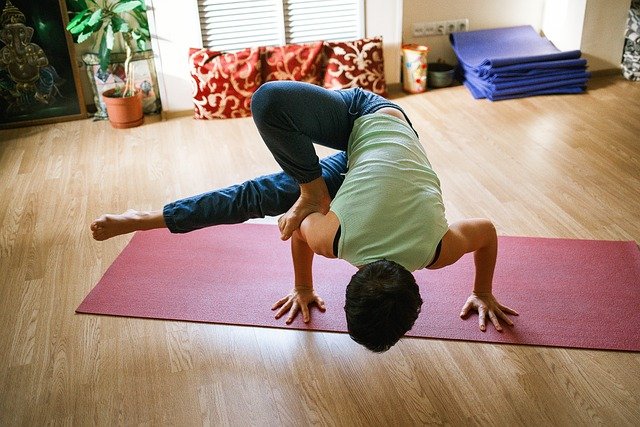Choosing and Caring for a Yoga Mat
A reliable yoga mat makes daily practice more comfortable, safer, and more inviting whether you exercise at a studio or at home. This article explains practical features to look for, how different mats support various exercise styles, and basic upkeep so a mat stays functional longer. It covers materials, grip, portability, and environmental considerations to help you match a mat to your routine and space.

This article is for informational purposes only and should not be considered medical advice. Please consult a qualified healthcare professional for personalized guidance and treatment.
Yoga: What to consider when buying a mat
A good yoga mat balances cushioning, grip, weight, and durability. Thickness choices commonly range from thin travel mats (about 1–2 mm) to standard practice mats (~3–5 mm) and extra-cushioned options (6–8 mm). Thicker mats add comfort for joints during floor poses but can reduce stability in balance postures. Texture affects traction; look for a surface that provides grip without being overly sticky. Also think about size—longer or wider mats accommodate taller practitioners or wider stances.
Consider personal factors like whether you sweat heavily, need a lightweight option for carrying, or prefer eco-friendly materials. For hot or vigorous yoga, absorbent or textured surfaces that maintain grip when damp are valuable. If you plan to use the mat for other floor-based exercise, such as pilates or bodyweight workouts, prioritize durability and cushioning appropriate to those movements.
Mat: Thickness, grip, and portability
Mat thickness and density determine both comfort and stability. Dense foam offers firm support but can feel harder than softer foams of the same thickness. Lightweight travel mats fold or roll small for trips but may sacrifice cushioning. Grip comes from the combination of surface material and texture pattern; some mats use natural rubber or closed-cell PVC to create a tacky feel. Consider whether you need a reversible mat with different textures on each side for diverse uses.
Portability matters if you carry a mat between home, a class, or outdoor sessions. Look at total rolled size, weight, and whether a carry strap or bag is helpful. Cleaning needs also vary: closed-cell mats resist sweat and are easier to wipe down, while open-cell or natural fiber mats might require more careful care to prevent odor and degradation.
How a mat supports exercise practice
A mat provides a stable, non-slip surface that reduces the risk of sliding during poses and exercises. For balance-focused practices, a mat with a firmer foundation and reliable traction helps maintain alignment. For restorative or gentle practices, extra cushioning protects knees, hips, and tailbone. Mats also create a defined personal space that can aid concentration and routine, whether practicing sequences, stretching after workouts, or using the mat for core work.
Beyond physical support, a familiar mat can contribute to psychological readiness for exercise: consistent texture, scent, and placement in a home fitness area can signal the body and mind that it’s time to move. Match the mat to the primary type of exercise you do most often to get the best support for that activity.
Choosing mats for different fitness styles
Different fitness activities place distinct demands on a mat. For hot yoga or vigorous vinyasa, choose a mat with strong moisture management and high traction to avoid slipping when sweaty. For pilates or floor-based strength workouts, thicker, more cushioned mats reduce impact on joints. If you use the mat outdoors, UV resistance and easy cleaning become priorities. Cross-training or high-intensity interval sessions may require a mat that balances cushion with durability against heavier use.
If multiple activities are part of your routine, consider keeping two mats: a dedicated practice mat for yoga and a more robust exercise mat for strength or cardio work. That separation can prolong the life of each mat and ensure the surface characteristics meet the specific demands of each style.
Maintaining a yoga mat at home
Regular cleaning and correct storage extend a mat’s usable life. For routine care, wipe down closed-cell mats with a mild soap solution and water or a store-bought mat cleaner; avoid harsh chemicals that break down foam or natural rubber. For natural or open-cell mats, follow manufacturer guidance—often gentle rinsing and air drying in shade is recommended to avoid cracking or brittleness. Allow mats to dry fully before rolling to prevent trapped moisture and odor.
Store mats flat or loosely rolled in a cool, dry place away from direct sunlight which can degrade materials over time. Inspect a mat periodically for thinning areas, loss of grip, or breakage; replace a mat when it no longer provides adequate traction or cushioning for safe practice.
Conclusion
Choosing the right yoga mat involves matching material, thickness, traction, and portability to your primary exercise routines and home setup. Regular care and mindful storage help preserve grip and comfort across many uses, while considering environmental impact and personal needs will guide an informed choice. With the right mat, daily practice and fitness sessions can feel more secure and comfortable over the long term.






